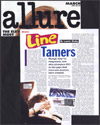Line Tamers
Allure – March 1995
Though they’re temporary, new skin plumpers fill in the gaps that time and emotion have created. Filling agents are injected into crow’s feet, smile grooves, pucker lines, and forehead furrows. The perfect wrinkle filler would be permanent, painless, and free of side effects, but does not exist. Pure liquid silicone was declared illegal by the FDA, citing such adverse reactions as reddening, swelling, and lumpiness under the skin. Injectable collagen is the most widely used filling agent in the United States. The injection technique calls for serial punctures – maybe 20 needle pricks along a line. After patients pass the required allergy test for collagen, wrinkles are injected every month until “correction” is achieved. Then touch-up shots are needed twice a year to keep the skin aloft. About three percent of the population is allergic to bovine collagen and it cannot be given to people who have an autoimmune disease, such as lupus and rheumatoid arthritis. Vanity isn’t behind every decision to erase wrinkles.
When a forty-something TV host unconsciously raised his eyebrows as he talked, he was told by his director, “You gotta stop! All we’re looking at is those lines across your forehead!” Injections of Botox wiped out those lines, says William Binder, M.D., an assistant clinical professor of dermatology at the UCLA School of Medicine and a pioneering researcher on Botox.
Though not a filler, Botox (a trade name for botulism toxin) acts on the source of wrinkles by temporarily paralyzing the specific muscles that form expression lines. The effects wear off in three to six months, then require a booster. Though not approved by the FDA for eliminating wrinkles, Botox is approved for uncontrolled muscle twitches around the eye. Binder cautions that Botox is indicated only for the upper third of the face. Injecting it anywhere else could make it impossible to smile or cause the lips to droop. People under 50 respond better to Botox, says Binder, but like most other wrinkle treatments, Botox is “technique dependent.” A form of hyaluronic acid (a natural component of the skin), hylan gel, not yet approved by the FDA, can be injected deeply or superficially, reports no allergic reactions, and may last for as long as a year. The only drawback appears to be temporary redness and swelling at the injection site.

